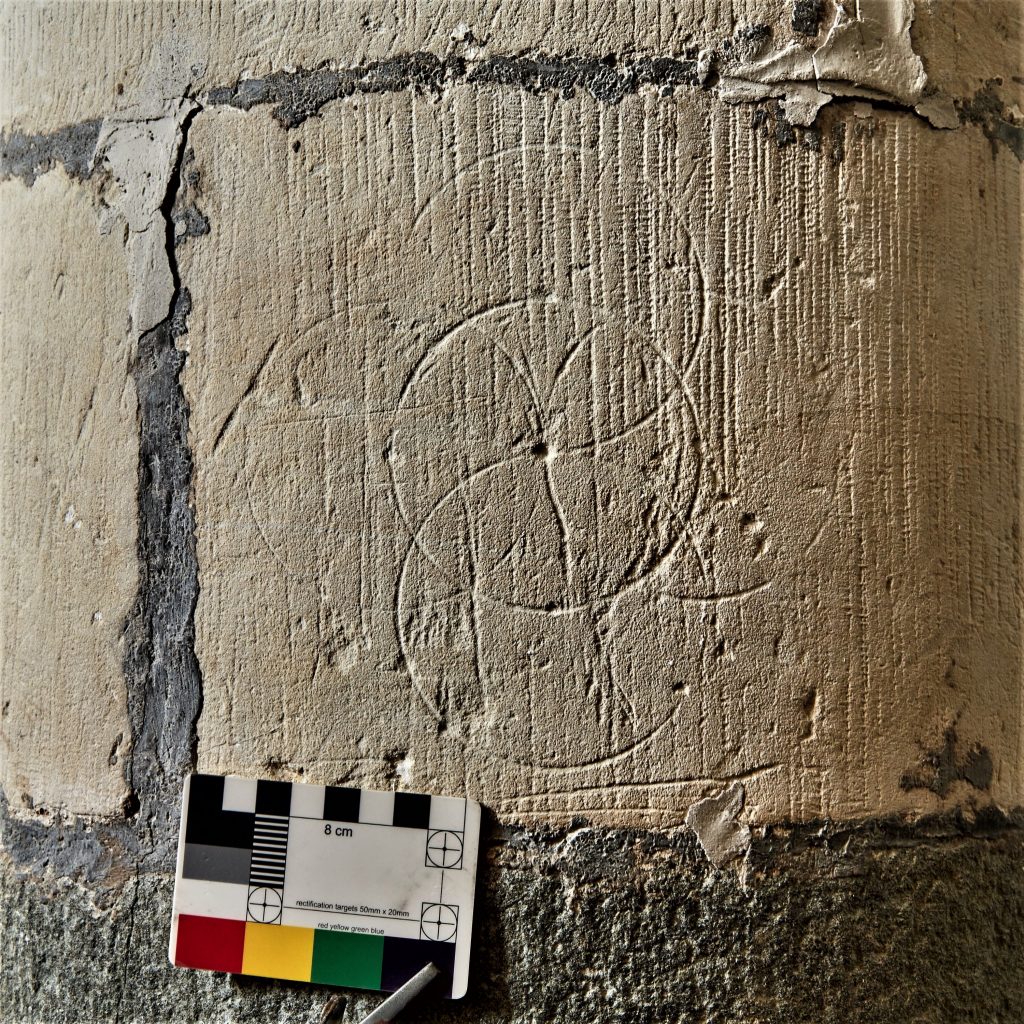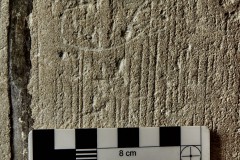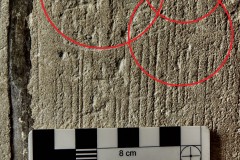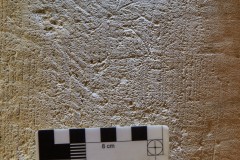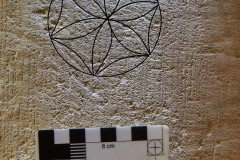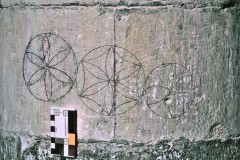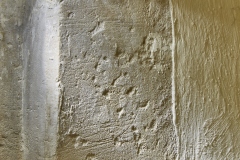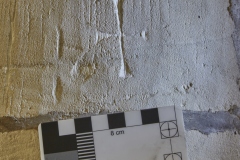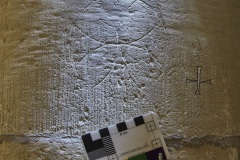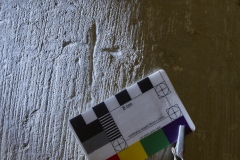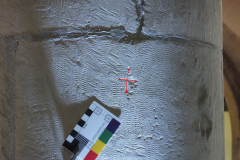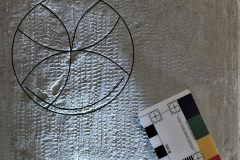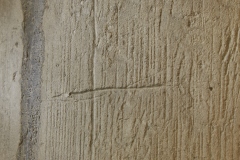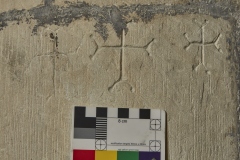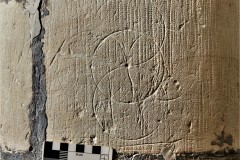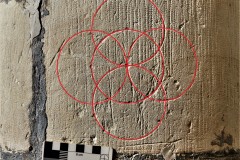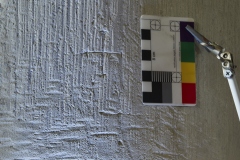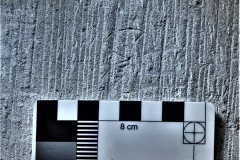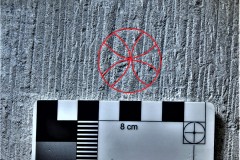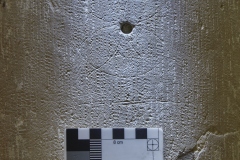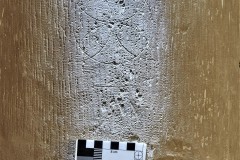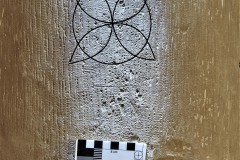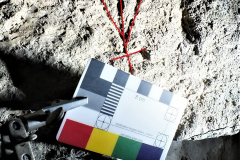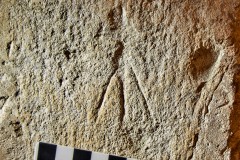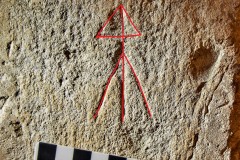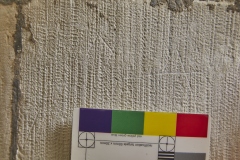St Dunstan’s, Snargate, Kent
In 2018 the Kent Medieval Graffiti Survey undertook the graffiti survey of the 14 medieval churches on Romney Marsh. One of these is in East Sussex, St Mary East, Guldeford, the rest are spread out across the rest of the Marsh. In late 2017, several members of the survey made a preliminary visit to look at a few of these churches and St Dunstan was the first we visited.
We returned several times from the following May, using this church and others to train new volunteers. The church was built in several stages, the extant medieval sections are the north and south aisles, the latter dating from around 1300, with the former a being a little later. The north and south chapels, the former dating from the 14th century, the latter being a little later.
Apart from the graffiti, this church had several points that appealed to us, the entrance to a bat roost was obvious in the southeast corner of the north chapel. These are not unusual we often see evidence of bats but I had great pleasure telling my daughter-in-law, a conservationist who specialises in bats about the roost, which she did not know of. Then there were the horse chestnuts spelling out the name St Dunstan put on the floor in front of the font for a festival. These the church mice then moved, rolling them around overnight, even moving some for much of the length of the church to a tomb in the north chapel.
The graffiti we found here was varied, much is of excellent quality and will be described by type in alphabetical order. Some of the graffiti was faint, at times even when produced it could barely have scratched the surface. However, if, as was often the case, the pillar was brightly painted the lighter coloured stone would have been clearly visible, make deeper incisions unnecessary.
Apotropaic Graffiti
The apotropaic graffiti of this church is found on the pillars of the aisles. One theory is that protective marks worked on the premise that evil entities were less than bright and would follow a line to its end, so some believe endless lines were intended to trap them for eternity.
The first two photos show a group of three faint interlocking compass drawn circles, on the pillar west of the south door in the south aisle. More intricate and certainly more aesthetically pleasing when enhanced were the compass drawn marks sometimes referred to as daisy wheels as in numbers 3 & 4, these are on the first pillar of the south aisle east of the south door.
These marks could be devotional, the daisy was the flower of the Virgin Mary and the Infant Christ. However, in most contexts they are often believed to be apotropaic, as is the case here. The two in photos no 5 & 6, which are on the same pillar of those above, show the simplest form of this design, that on the left, while that on the right shows a more intricate design similar to that in no 4. The compass drawn cross in the photo with the daisy wheels could be devotional but being so close to the other two it is thought more likely that it is apotropaic. Another of the simple version of these designs is found on the central pillar of the north aisle, photo no 7.
Compass drawn apotropaic marks can be simple circles as in numbers 8 & 9. Photo no 8 is on the first pillar of the south aisle, while the other is one of several arcs of circles found in the north niche of the east pillar of the north aisle, shown in photo no 9. Exactly what these latter are is not known but they seem more likely to be apotropaic than anything else.
Crosses
There are perhaps more crosses found than any other class of graffiti in this church. Although the majority are very well produced and in good condition, a few are rather crude and/or damaged. All were found on the pillars of the aisles, mainly the south aisle. The cross photos numbers 1 to 14 show the crosses of the south aisle. Photo no 1 is a pattee cross on the first pillar west of the south door, while photo no 2 shows a compass drawn cross on the same pillar, with a faint pattee cross alongside it. This latter cross is shown enhanced in photo no 3. Some crosses are a rather roughly produced, as in no 4. This cross, also on the same pillar, is relatively deeply inscribed but it seems that an attempt has been made to erase it. There is a rough St Andrew’s Cross on the first pillar east of the south door, photo no 5. Also, on this pillar is a rather neat but damaged small cross, no 6, shown enhanced in no 7. As there are a few damaged pieces of graffiti, such as this, it is thought that attempts may have been made to remove these.
At times, a graffito is found that appears to be incomplete, such as that in photos no 8 and 9, on the same pillar. This is a compass drawn cross on which one side of one arm has not been drawn. Missing sections of apotropaic graffiti are thought by some to indicate that its purpose has been reversed. However, in this case, largely because the quality is fairly poor, this is not thought to be the case here. Another poorly executed cross is in picture no 10, apart from this being on the second pillar east of the south door, there is little else to say about this graffito.
Also on this pillar is a personal favourite, no 11, three crosses of the same basic design. That is as far as the similarity goes, the quality of the centre cross is superior to the other two, it is also slightly larger and possibly chisel cut. The image on the left is much less deeply incised than the others. A personal possible theory, is that the centre cross was incised first and the others added later, probably to indicate the execution of Christ.
There is a compass drawn design in the south aisle, shown in numbers 12 & 13, on the second pillar east of the south door that is possible to interpret in two ways. At first glance it seems to be simply five overlapping circles but where the outer circles cross the inner one a cross is produced. Because of this it was decided to class this as a cross, it must though be born in mind that it could equally be classed as apotropaic. The final graffito, photo no 14, on both this pillar and aisle is what seems to be a simple version of a Pisana cross. Simply a plain cross with bars crossing the ends of the arms.
The crosses found in the north aisle were all on the first pillar east of the south door. Shown on numbers 15 & 16, is a small, 3cm in diameter, well executed but feint, compass drawn cross. This appears to be one of those graffito which, in places, just scratched through the paint, that could originally have covered this pillar. Two more compass drawn crosses were found on this pillar and are shown in photos 17 – 19.
Heraldic Graffiti
Only one piece of heraldic graffiti, numbers 1 & 2, was found in St Dunstan’s. This in an inverted shield located on middle pillar of the North aisle. Even today at military funerals etc troops carry their arms reversed, that is upside down, as a mark of respect. It is possible that an inverted shield indicates that its owner is dead, that is if the markings on it refer to a real person.
Mason’s Marks
Masons mark their work for a variety of reasons, they can indicate who worked on that piece of stone, these are the “bankers”. Named for the stone bench on which they were produced, these allow the craftsman to be identified for quality control and payment.
Masons also needed to identify which arch or pillar the stone was to be place in and often which two stones butted together. At times, working marks were made which seemed to have been intended to ensure that the stones were laid at the correct angle to each other.
Photo no 1, shows what appears to be this latter type of marking. This is on the east face of the east window of the south chapel; however it is not known what it is actually intended for. Numbers 2 & 3 show a mason’s banker mark on the back face of the 20th step in the tower stairs both the original photo and an enhanced copy. This is very similar but not identical to one found on the west side of the porch, numbers 5 & 5, again both the original and an enhanced version.
Textual Inscriptions
A number of textual inscriptions were found, the vast majority being modern i.e. 17th century or later. Photo No 1 shows the initials AFN or AFW, these have been found in most of the churches surveyed by the Kent Medieval Graffiti Survey. I have also seen these in one or two Buckinghamshire churches. Thanks to a find in St George Ivychurch we can now roughly date these. There we found a pair of initials, that above and BLW, the pair being dated 1944. It is then highly unlikely that we will find very recent inscriptions by this person. This at St Dunstan’s is located on the first pillar of the south aisle west of the south doorway.
On the second pillar from the east of the south aisle are the modern letters N and A, photo number 2; and are nothing special. The name Will and a small compass drawn circle were found on the west end of the north pews, photo number 3. On the vertical face of the sill of the southeast window are the initials EB, a chisel cut T, some indistinct and numbers. These are shown in photo number 4.
There is a small piece of indistinct script and a cross in a hand drawn circle, shown in numbers 5 & 6. This seems to be one word, however, to date it has not been possible decipher it. This is on the sill of the south window of the south chapel.
More letters and initials are to be found on the windows of the south wall. Photo number 7 shows the letters M and A, on the sill of third window from the East. More letters are to be found on the sill of this window, a reversed letter F, a lower case H, what seems to be an inverted capital T and a capital C. There is also what could be a cross or a lower case T. These are shown in photo number 8.
Finally, on the east side of the font is a small capital letter T. This looks as though it may have been chisel cut but this is not clear.
There are some very nice pieces of graffiti in St Dunstan’s but none that could be called really exceptional.
Report by Alan Anstee.
St Dunstan’s Church
Snargate
Kent
TN29 9RX
Search Terms: compass drawn circle, cross, pattee cross, st andrew’s cross,pisana cross, heraldic graffiti, mason’s marks, banker mark, text, initials, N, A, AFN, AFW, EB, BLW, T, C, MA, WILL, shield

